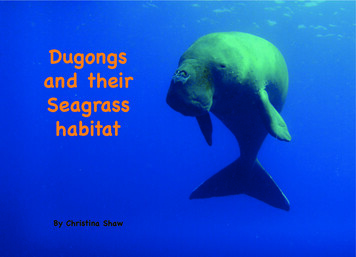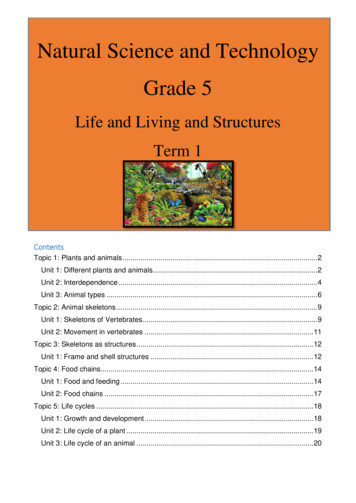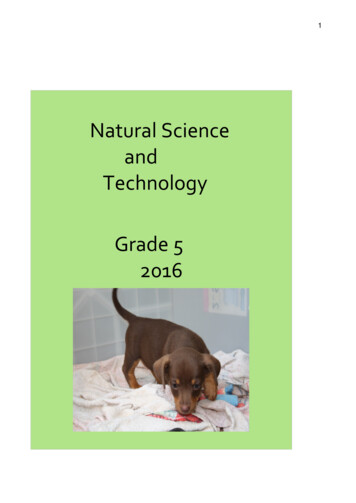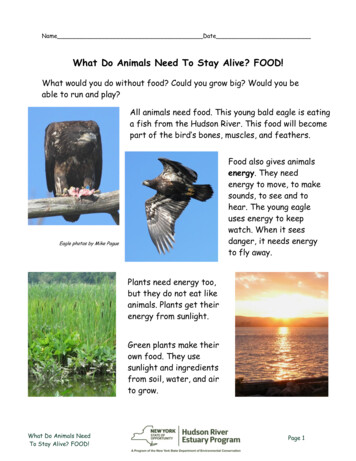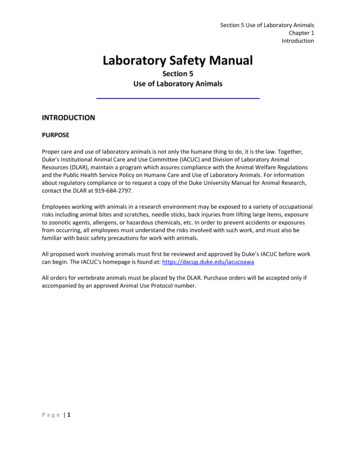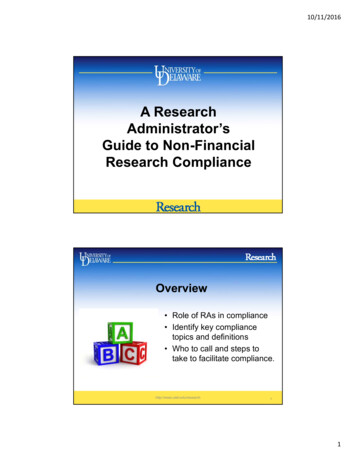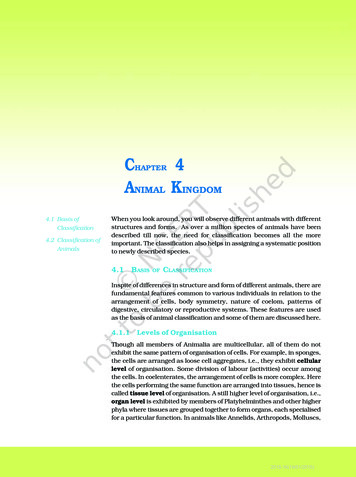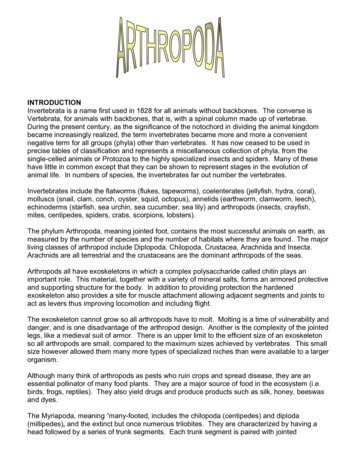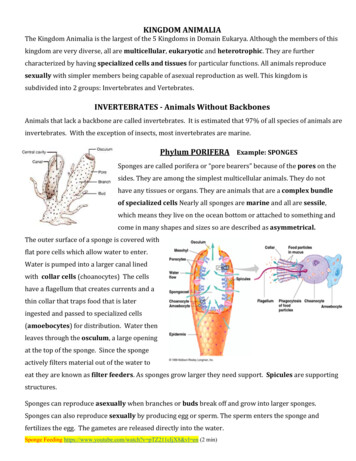
Transcription
KINGDOM ANIMALIAThe Kingdom Animalia is the largest of the 5 Kingdoms in Domain Eukarya. Although the members of thiskingdom are very diverse, all are multicellular, eukaryotic and heterotrophic. They are furthercharacterized by having specialized cells and tissues for particular functions. All animals reproducesexually with simpler members being capable of asexual reproduction as well. This kingdom issubdivided into 2 groups: Invertebrates and Vertebrates.INVERTEBRATES - Animals Without BackbonesAnimals that lack a backbone are called invertebrates. It is estimated that 97% of all species of animals areinvertebrates. With the exception of insects, most invertebrates are marine.Phylum PORIFERA Example: SPONGESSponges are called porifera or “pore bearers” because of the pores on thesides. They are among the simplest multicellular animals. They do nothave any tissues or organs. They are animals that are a complex bundleof specialized cells Nearly all sponges are marine and all are sessile,which means they live on the ocean bottom or attached to something andcome in many shapes and sizes so are described as asymmetrical.The outer surface of a sponge is covered withflat pore cells which allow water to enter.Water is pumped into a larger canal linedwith collar cells (choanocytes) The cellshave a flagellum that creates currents and athin collar that traps food that is lateringested and passed to specialized cells(amoebocytes) for distribution. Water thenleaves through the osculum, a large openingat the top of the sponge. Since the spongeactively filters material out of the water toeat they are known as filter feeders. As sponges grow larger they need support. Spicules are supportingstructures.Sponges can reproduce asexually when branches or buds break off and grow into larger sponges.Sponges can also reproduce sexually by producing egg or sperm. The sperm enters the sponge andfertilizes the egg. The gametes are released directly into the water.Sponge Feeding https://www.youtube.com/watch?v pTZ211cIjX8&vl en (2 min)
Phylum CNIDARIA or COLENTRATES Example: Jelly Fish, Sea AnemoneSometimes called Coelenterates this phylum includes organisms that are mainly marine. Cnidarians aremore complex than sponges. They have tissuesspecialized to perform specific functions. Unlike Spongeswhich have no symmetry, Cnidarians are radiallysymmetrical. Radial Symmetry means body parts arerepeated around the central part of the body.Cnidarians have 2 body forms: polyp -a sessilecylindrical sac-like body or a motile bell like medusaform. Both have a centrally located mouth surroundedby tentacles.Almost all Cnidarians are carnivores. They usually usenematocysts (stinging structures) located on theirtentacles to sting or even paralyze their prey. Food is pulled into the mouth which opens into a blind gut(sac like cavity) where it is digested. Due to their acoelomate (single opening) body plan wastes mustleave through the mouth.Swimming Anemone https://www.youtube.com/watch?v ysOmq71fcMk (1:30)Like sponges Cnidarians are capable of both asexual and sexualreproduction with many medusae members beginning life as a polypbecoming free swimming as an adult.Jellyfish 101: https://www.youtube.com/watch?v 9z8ujpPgUjI (3:50)Phylum PLATYHELMINTHES, Phylum NEMATODA, Phylum ANNELIDAMembers of these 3 Phyla are commonly called worms.These organisms are all bilaterally symmetricalmeaning only symmetrical in one direction with a front(anterior) end and a back (posterior) end. They alsohave a back (dorsal) surface and a belly (ventral)surface. All have evolved organs to perform lifefunctions.
Platyhelminthes – Example: Planaria, Tapeworm“Flatworms” are the simplest invertebrates that haveorgans and organ systems. They have a simple brainand nervous system that coordinates the movement ofthe muscular system. This concentration of nerves in theanterior end is called Cephalization.Planaria are free-living carnivores. They have a pharynxused to take in food and digest it. Waste goes out thepharynx as well. They have eyespots to detect light.This is the first time we see some type of nervous system.Planaria Regeneration https://www.youtube.com/watch?v w0QzSYQGsnA (0:30)Tapeworms attach themselves inside the intestines and absorb thenutrients the host takes in. Some can grow up to 50 feet in length.Tapeworms do not have a digestive system because they areparasitic and the organism they live in has already digested thefood so they don’t need one. This allows room for a well developedreproductive system in the form of proglottids. Each one containsboth male and female reproductive structures.Nematoda – example: Ascaris, Hook worm“Roundworms” have a tubular digestivesystem running through the body with aseparate mouth and anus. They get theircylindrical shape from a fluid-filled body cavity(pseudocoel) between the digestive tract and the body wall which acts as a hydrostatic skeleton. Mostmembers are parasitic, covered with a tough cuticle. Nematodes reproduce sexually with separate sexes.Parasitic hookworms https://www.youtube.com/watch?v 44aq2A6NkUw (2:07)Annelida – Earthworm, LeachAnnelids are known as “Segmented Worms” and as such are thefirst invertebrates to show true segmentation & covering on theirdigestive tract (peritoneum). The space (coelom) created by theperitoneum allows for the development of organs. Segmentationallows for specialization of body regions (development of body systems) & more efficient movement.You will learn more about annelids in the Earthworm Dissection.Medicinal Leeches https://www.youtube.com/watch?v O-0SFWPLaII (3:40)
Phylum MOLLUSCA Example: Snails, Clams and OctopusesThe name Mollusc comes from the Latin word “mollis,” which means “soft.” Molluscs have a soft bodyprotected by a calcium carbonate shell. Some molluscs have an internal shell called a pen (squid). A thinlayer of tissue called the mantle covers the unsegmented body and produces the shell. The body isusually bilaterally symmetrical with a ventral, muscular foot used for locomotion. Most Molluscs havea head that includes eyes and an open circulatory system (the heart pumps blood through tubes whichwashes over organs). Three common Classes of Molluscs are gastropods (snails), bivalves (clams,oysters) and cephalopods (squid and octopus).Gastropods are typically a coiled body mass tucked into a shell. Somemolluscs use a file-like tongue or radula to scrape algae off of rocks. Othermolluscs are soft bottom feeders or even carnivores.Bivalves are clams, mussels and oysters and othersimilar molluscs. They retain the body plan and arecompressed in a two-valved shell. The inner part of theshell is lined with the mantle. There is no head orradula. Siphons pull water over the gills for breathingas well as filtering small food particles. If a foreign particle becomes caught between the mantle and thebody, the mantle will secrete calcium carbonate over top of it resulting in a pearl. Strong muscles areused to keep the shell closed. Clams will use their shovel shaped foot to move and to bury themselves inthe bottom sediment.Cephalopods include squid and octopus. They are agile swimming carnivores and have their foot dividedinto arms equipped with suckers to capture prey. They have a well-developed brain & excellent vision.Cephalopods use jet propulsion to move. The water enters through the open end of the mantle cavityand is forced out through a muscular tube called the funnel.Octopuses have 8 long arms & lack ashell. They are efficient hunters & bitewith a pair of beak-like jaws. Ifthreatened, they can emit a dark inkproduced by the ink sac, to distractpredators.Octopus Opens a Jar https://www.youtube.com/watch?v 9kuAiuXezIU (2:50)
Phylum ARTHROPODA Example: Lobster, Spider, DragonflyArthropods make up the largest phylum of animals with over 1 million species occupying all habitatson Earth. The arthropod body is bilaterally symmetrical, segmented & covered by a tough nonlivingchitinous exoskeleton. The exoskeleton provides protection for well-developed body systems but mustbe shed (molted) thus limiting their size. Muscles are attached to jointed appendages like legs andmouth parts which areadapted for a particularlifestyle allowing forwalking, flying or swimming.Arthropods have an opencirculatory system andcephalization (a concentration of sensory organs in the head region) Most arthropod species haveseparate sexes. Many species have larvae that look nothing like the adult & go through metamorphosis.This contributes to the success of the Phyla as the young do not compete with adults for food. FamiliarClasses of Arthropods are Insects (Bee), Arachnids (spiders) & Crustaceans (lobster).Arthropod Adaptations https://www.youtube.com/watch?v bz4ODmqbnQA (3:40)Phylum ECHINODERMS Example: starfish, sea urchins & sand dollarsEchinodermata means “spiny-skinned”. Although sometimes thespikes look external they are part of an endoskeleton (internal) &are really covered with a thin layer of ciliated tissue. Not allechinoderms have spines (ie. Sand dollars). Adults are radiallysymmetrical while larvae are bilateral making them our closestinvertebrate relative. Their radial symmetry is based on fiverepeating pieces as they lack a head (anterior) region. The twosides of an echinoderm are the oral side (containing the mouth) &the aboral side (with the anus). Echinoderms have an evertablestomach so feed by extending the stomach outward secreting digestive enzymes to begin digestionexternally. Nutrients are then absorbed & the stomach is pulled back into the body.Echinoderms have a water vascular system of canals attached to muscular tube feet. These water-filledchannels create hydrostatic pressure within the tube feet for movement and adhesion. The nervoussystem is a simple nerve net that coordinates the movement of the tube feet and spines with the absenceof a brain. The sexes are separate in most echinoderms. Asexual reproduction is through regeneration.An arm can produce a new organism if a piece of the central disk is intact or present.Starfish walking & feeding tion-sea-star-body-plan (3:50)
Phylum ARTHROPODA Example: Lobster, Spider, Dragonfly Arthropods make up the largest phylum of animals with over 1 million species occupying all habitats on Earth. The arthropod body is bilaterally symmetrical, segmented & covered by a tough nonliving chitinous exoskeleton. The exoskeleton provides protection for well-developed body systems but must

